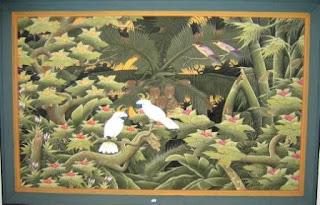 Despite the adoption of modern western painting traditions by manyBalinese and Indonesian painters, the neo-traditional Balinese painting
Despite the adoption of modern western painting traditions by manyBalinese and Indonesian painters, the neo-traditional Balinese painting
tradition is still thriving and continues by descedents/students of the artists of the pre-war modernist era (1928-1942). The schools of
neo-traditional Balinese painting include: Ubud, Batuan, Sanur, Young Artist and Keliki schools of painting Ubud has been the center of art for centuries, with the surrounding royal houses and temples as the main patrons. Prior to the 1920s, traditional wayang style paintings dominated the subject matters, although Jean Couteau (1999) believes that both secular and religious theme paintings have long been co-existing in the form of the expression of the unity of opposites (Rwabhinneda in Balinese belief system).The Batuan school of painting is practiced by brahman artists in the village of Batuan, which is situated ten kilometers to the South of Ubud. The Batuan artisans are gifted dancers, sculptors and painters. Major Batuan artists from the pre-modernist era include I Dewa Njoman Mura (1877-1950) and I Dewa Putu Kebes (1874-1962), who were known as sanging; traditional Wayang-style painters for temples' ceremonial textiles.The development of the Young Artist School of painting is attributed to the Dutch artist Arie Smit, a Dutch soldier who served during the 2nd world war and decided to stay in Bali. In the early 1960s, he came across children in the village of Penestanan near Tjampuhan drawing on the sand. He encouraged these children to paint by providing them with paper and paints.
Saturday, August 23, 2008
Balinese paintings
Subscribe to:
Post Comments (RSS)



Komentar :
Post a Comment